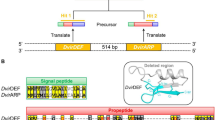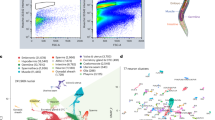Abstract
Thioredoxins are small thiol proteins that have a conserved active site sequence, WCGPC, and reduce disulfide bonds in various proteins using the two active site cysteines, a reaction that oxidizes thioredoxin and renders it inactive. Thioredoxin reductase returns thioredoxin to its reduced, active form in a reaction that converts NADPH to NADP+. The biological functions of thioredoxins vary widely; they have roles in oxidative stress protection, act as electron donors for ribonucleotide reductase, and form structural components of enzymes. To date, three thioredoxin genes have been characterized in Drosophila melanogaster: the generally expressed Thioredoxin-2 (Trx-2) and the two sex-specific genes ThioredoxinT (TrxT) and deadhead (dhd). The male-specific TrxT and the female-specific dhd are located as a gene pair, transcribed in opposite directions, with only 470 bp between their transcription start points. We show in this study that all three D. melanogaster thioredoxins are conserved in 11 other Drosophilid species, which are believed to have diverged up to 40 Ma ago and that Trx-2 is conserved all the way to Tribolium castaneum. We have found that the intriguing gene organization and regulation of TrxT and dhd is remarkably well conserved and identified potential conserved regulatory sequences. In addition, we show that the 50–70 C terminal amino acids of TrxT constitute a hyper-variable domain, which could play a role in sexual conflict and male–female co-evolution.






Similar content being viewed by others
References
Ashburner M, Golic KG, Hawley RS (2005) Drosophila: a laboratory handbook. Cold Spring Harbor Laboratory, Cold Spring Harbor, N.Y.
Ayyar S, Jiang J, Collu A, White-Cooper H, White RA (2003) Drosophila. TGIF is essential for developmentally regulated transcription in spermatogenesis. Development 130:2841–2852
Bailey TL, Elkan C (1994) Fitting a mixture model by expectation maximization to discover motifs in biopolymers. Proc Int Conf Intell Syst Mol Biol 2:28–36
Bauer H, Kanzok SM, Schirmer H (2002) Thioredoxin-2 but not thioredoxin-1 is a substrate of thioredoxin peroxidase-1 from Drosophila melanogaster: isolation and characterization of a second thioredoxin in D. melanogaster and evidence for distinct biological functions of Trx-1 and Trx-2. J Biol Chem 277:17457–17463
Betrán E, Thornton K, Long M (2002) Retroposed new genes out from the X in Drosophila. Genome Res 12:1854–1859
Burke-Gaffney A, Callister ME, Nakamura H (2005) Thioredoxin: friend or foe in human disease. Trends Pharmacol Sci 26:398–404
Ferguson EL, Horvitz HR (1989) The multivulva phenotype of certain Caenorhabditis elegans mutants results from defects in two functionally redundant pathways. Genetics 123:109–121
Frank LH, Cheung HK, Cohen RS (1992) Identification and characterization of Drosophila female germ line transcriptional control elements. Development 114:481–491
Gromer S, Urig S, Becker K (2004) The thioredoxin system–from science to clinic. Medicinal Res Rev 24:40–89
Heifetz Y, Lung O, Frongillo EA, Wolfner MF (2000) The Drosophila seminal fluid protein Acp26Aa stimulates release of oocytes by the ovary. Curr Biol 10:99–102
Herndon LA, Wolfner MF (1995) A Drosophila seminal fluid protein, Acp26Aa, stimulates egg laying in females for 1 day after mating. Proc Natl Acad Sci U S A 92:10114–10118
Hiller M, Chen X, Pringle MJ, Suchorolski M, Sancak Y, Viswanathan S, Bolival B, Lin TY, Marino S, Fuller MT (2004) Testis-specific TAF homologs collaborate to control a tissue-specific transcription program. Development 131:5297–5308
Holmgren A (1984) Enzymatic reduction-oxidation of protein disulfides by thioredoxin. Methods Enzymol 107:295–300
Holmgren A (1989) Thioredoxin and glutaredoxin systems. J Biol Chem 264:13963–13966
Hughes AL, Nei M (1988) Pattern of nucleotide substitution at major histocompatibility complex class I loci reveals overdominant selection. Nature 335:167–170
Jee C, Vanoaica L, Lee J, Park BJ, Ahnn J (2005) Thioredoxin is related to life span regulation and oxidative stress response in Caenorhabditis elegans. Genes to Cells 10:1203–1210
Jiang J, White-Cooper H (2003) Transcriptional activation in Drosophila spermatogenesis involves the mutually dependent function of aly and a novel meiotic arrest gene cookie monster. Development 130:563–573
Jordan BF, Runquist M, Raghunand N, Gillies RJ, Tate WR, Powis G, Baker AF (2005) The thioredoxin-1 inhibitor 1-methylpropyl 2-imidazolyl disulfide (PX-12) decreases vascular permeability in tumor xenografts monitored by dynamic contrast enhanced magnetic resonance imaging. Clin Cancer Res 11:529–536
Laurent TC, Moore EC, Reichard P (1964) Enzymatic synthesis of deoxyribonucleotides. IV. Isolation and characterization of thioredoxin, the hydrogen donor from Escherichia coli. B J Biol Chem 239:3436–3444
Martin JL (1995) Thioredoxin - a fold for all reasons. Structure 3:245–250
Miranda-Vizuete A, Sadek CM, Jiménez A, Krause WJ, Sutovsky P, Oko R (2004) The mammalian testis-specific thioredoxin system. Antioxid Redox Signal 6:25–40
Miranda-Vizuete A, González JC, Gahmon G, Burghoorn J, Navas P, Swoboda P (2006) Lifespan decrease in a Caenorhabditis elegans mutant lacking TRX-1, a thioredoxin expressed in ASJ sensory neurons. FEBS Lett 580:484–490
Mukai M, Kitadate Y, Arita K, Shigenobu S, Kobayashi S (2006) Expression of meiotic genes in the germline progenitors of Drosophila embryos. Gene Expr Patterns 6:256–266
Nishinaka Y, Masutani H, Nakamura H, Yodoi J (2001) Regulatory roles of thioredoxin in oxidative stress-induced cellular responses. Redox Report 6:289–295
O’Neil MT, Belote JM (1992) Interspecific comparison of the transformer gene of Drosophila reveals an unusually high degree of evolutionary divergence. Genetics 131:113–128
Orr MD, Vitols E (1966) Thioredoxin from Lactobacillus leichmannii and its role as hydrogen donor for ribonucleoside triphosphate reductase. Biochem Biophys Res Commun 25:109–115
Parisi M, Nuttall R, Naiman D, Bouffard G, Malley J, Andrews J, Eastman S, Oliver B (2003) Paucity of genes on the Drosophila X chromosome showing male-biased expression. Science 299:697–700
Park M, Wolfner MF (1995) Male and female cooperate in the prohormone-like processing of a Drosophila melanogaster seminal fluid protein. Dev Biol 171:694–702
Pellicena-Palle A, Stitzinger SM, Salz HK (1997) The function of the Drosophila thioredoxin homologue encoded by the deadhead gene is redox-dependent and blocks the initiation of development but not DNA synthesis. Mech Dev 62:61–65
Peng J, Chen S, Büsser S, Liu H, Honegger T, Kubli E (2005) Gradual release of sperm bound sex-peptide controls female postmating behavior in Drosophila. Curr Biol 15:207–213
Perezgasga L, Jiang J, Bolival B, Hiller M, Benson E, Fuller MT, White-Cooper H (2004) Regulation of transcription of meiotic cell cycle and terminal differentiation genes by the testis-specific Zn-finger protein matotopetli. Development 131:1691–1702
Russo CA, Takezaki N, Nei M (1995) Molecular phylogeny and divergence times of drosophilid species. Mol Biol Evol 12:391–404
Salz HK, Flickinger TW, Mittendorf E, Pellicena-Palle A, Petschek JP, Albrecht EB (1994) The Drosophila maternal effect locus deadhead encodes a thioredoxin homolog required for female meiosis and early embryonic development. Genetics 136:1075–1086
Schmid KJ, Tautz D (1997) A screen for fast evolving genes from Drosophila. Proc Natl Acad Sci U S A 94:9746–9750
Stewart EJ, Aslund F, Beckwith J (1998) Disulfide bond formation in the Escherichia coli cytoplasm: an in vivo role reversal for the thioredoxins. EMBO J 17:5543–5550
Sumida Y, Nakashima T, Yoh T, Nakajima Y, Ishikawa H, Mitsuyoshi H, Sakamoto Y, Okanoue T, Kashima K, Nakamura H, Yodoi J (2000) Serum thioredoxin levels as an indicator of oxidative stress in patients with hepatitis C virus infection. J Hepatol 33:616–622
Svensson MJ, Larsson J (2007) Thioredoxin-2 affects lifespan and oxidative stress in Drosophila. Hereditas 144:25–32
Svensson MJ, Chen JD, Pirrotta V, Larsson J (2003) The ThioredoxinT and deadhead gene pair encode testis- and ovary-specific thioredoxins in Drosophila melanogaster. Chromosoma 112:133–143
Swanson WJ, Vacquier VD (2002) The rapid evolution of reproductive proteins. Nat Rev Genetics 3:137–144
Tamura K, Subramanian S, Kumar S (2004) Temporal patterns of fruit fly (Drosophila) evolution revealed by mutation clocks. Mol Biol Evol 21:36–44
Thackeray JR, Kyriacou CP (1990) Molecular evolution in the Drosophila yakuba period locus. J Mol Evol 31:389–401
Tsaur SC, Wu CI (1997) Positive selection and the molecular evolution of a gene of male reproduction, Acp26Aa of Drosophila. Mol Biol Evol 14:544–549
Wahl MC, Irmler A, Hecker B, Schirmer RH, Becker K (2005) Comparative structural analysis of oxidized and reduced thioredoxin from Drosophila melanogaster. J Mol Biol 345:1119–1130
White-Cooper H, Leroy D, MacQueen A, Fuller MT (2000) Transcription of meiotic cell cycle and terminal differentiation genes depends on a conserved chromatin associated protein, whose nuclear localisation is regulated. Development 127:5463–5473
Wollman EE, d’Auriol L, Rimsky L, Shaw A, Jacquot JP, Wingfield P, Graber P, Dessarps F, Robin P, Galibert F (1988) Cloning and expression of a cDNA for human thioredoxin. J Biol Chem 263:15506–15512
Wong A, Albright SN, Wolfner MF (2006) Evidence for structural constraint on ovulin, a rapidly evolving Drosophila melanogaster seminal protein. Proc Natl Acad Sci U S A 103:18644–18649
Acknowledgements
We thank Mariana Wolfner and Eric Kubli for providing antibodies. This work was supported by grants from the Nilsson-Ehle foundation to M.S., and from the Swedish Research Council, Carl Tryggers and Philip-Sörenssen foundations to J.L.
Author information
Authors and Affiliations
Corresponding author
Additional information
Communicated by P. Simpson
Rights and permissions
About this article
Cite this article
Svensson, M.J., Stenberg, P. & Larsson, J. Organization and regulation of sex-specific thioredoxin encoding genes in the genus Drosophila . Dev Genes Evol 217, 639–650 (2007). https://doi.org/10.1007/s00427-007-0175-y
Received:
Accepted:
Published:
Issue Date:
DOI: https://doi.org/10.1007/s00427-007-0175-y




